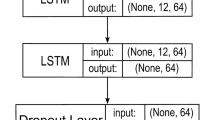Abstract
This paper identifies a problem of significance for approaches to adaptive autonomous agent research seeking to go beyond reactive behaviour without resorting to hybrid solutions. The feasibility of recurrent neural network solutions are discussed and compared in the light of experiments designed to test ability to handle long-term temporal dependencies, in a more situated context than hitherto. It is concluded that a general-purpose recurrent network with some processing enhancements can begin to fulfil the requirements of this non-trivial problem.
Similar content being viewed by others
References
Brooks, R. A.: A robust layered control system for a mobile robot, IEEE J. Robot. Anim. RA-2 (1986), 14–23
Brooks, R. A.: Intelligence without representation, Artif. Intel. 47 (1991), 139–159
Brooks, R. A.: Intelligence without reason, Proc. of the Twelfth Int. Conf. on Artificial Intelligence (IJCAI), Vol. 1, 1991, 569–595
Meeden, L.: Towards Planning, Incremental Investigations into Adaptive Robot Control, Ph.D. Thesis, Department of Computer Science, Indiana University, 1994.
Rylatt, R. M., Czarnecki, C. A. and Routen, T. W.: A neural network based adaptive controller for mobile robots. Proc. Twelfth Int. Conf. on Systems Engineering, Coventry, U.K., Vol. 2, 1997, 587–592.
Ziemke, T.: Towards adaptive perception in autonomous robots using second-order recurrent networks, Proc. First Euromicro Workshop on Advanced Mobile Robots, Kaiseslautern, 1996, 89–98.
Lin, L.-J. and Mitchell, T. M.: Reinforcement learning with hidden states. From Animals to Animats 2: Proc. Second Int. Conf. on the Simulation of Adaptive Behaviour, MIT Press, 1994, 271–280
Meeden, L.: An incremental approach to developing intelligent neural network controllers for robots. IEEE Trans. Syst., Man and Cybernetics, 26, (Special Issue on Learning Autonomous Robots), 1996.
Ziemke, T.: Towards adaptive behaviour system integration using connectionist infinite state automata. From Animals to Animats 4: Proc. Fourth Int. Conf. on the Simulation of Adaptive Behaviour, MIT Press/Bradford Books, Cambridge, MA., 1996.
Yamauchi, B. and Beer, R.: Integrating reactive, sequential and learning behaviour using dynamical neural networks. From Animals to Animats 3: Proc. Third Int. Conf. on the Simulation of Adaptive Behaviour, MIT Press, Cambridge, MA., 1994, 383–394.
Elman, J.: Finding structure in time, Cog. Sci. 14 (1990), 179–211.
Dorffner, G.: Neural networks and a new AI-questions and answers, In: Dorffner, G. (ed.) Neural Networks and a New Artificial Intelligence, International Thompson Computer Press, 1993.
Ulbricht, C.: Handling time-warped sequences with neural networks. From Animals to Animats 4: Proc. Fourth Int. Conf. on Simulation of Adaptive Behaviour, 1996, 180–192.
Verschure, P.M.: Connectionist explanation: taking positions in the mind-brain dilemma. In: Dorffner, G. (ed.) Neural Networks and a New Artificial Intelligence, International Thompson Computer Press, 1993, 134–187.
Clarke, A.: Associative engines: connectionism, concepts, and representational change. Bradford Books, MIT Press, Cambridge, MA. 1993.
Stein, L. A.: Imagination and situated cognition, In: Ford, K. M., Glymour, C. and Hayes, P. J., (eds), Android Epistemology, AAAI Press/Press, Menlo Park, CA, 1995.
Mozer,M. C.: Neural net architectures for temporal sequence processing, In: Weigend, A. and Gerschenfeld, N., (eds), Predicting the Future and Understanding the Past, Addison Wesley, 1993.
Ludik, J., Prins, W., Meert, K. and Catfolis, T.: A comparative study of fully and partially recurrent Networks. Proc. 1997 IEEE Int. Conf. on Neural Networks, (ICNN97), Houston, Texas, Vol. I, 292–297.
Cottrell, G. W. and Tsung, F. S.: Learning simple arithmetic procedures, In: Barnden, J. A. and Pollack J. B., (eds.), High-Level Connectionist Models, 1991, 305–321.
Lin, T., Horne, B. G., Tino, P. and Giles, L.: Learning long-term dependencies is not as difficult with NARX recurrent networks, IEEE Trans. Neural Networks, 1996.
Kadaba, N., Nygard, K. E., Juell, P. L. and Kanga, L.: Modular backpropagation network for large domain pattern classification. Proc. IJCNN, Washington D.C., Vol. II, 1990, 551–554.
Tani, J. and Fukumura, N.: Learning goal directed sensory-based navigation of a mobile robot. Neural Networks 7 (1994), 550–564.
Rylatt, R. M., Czarnecki, C. A. and Routen, T. W.: A partially recurrent gating network approach to learning action selection by reinforcement. Proc. 1997 IEEE Int Conf. on Neural Networks, (ICNN97), Houston, TX, Vol. III, 1997, 1689–1698.
Dreyfus, H. and Dreyfus, S.: Mind over Machine: the Power of Human Intuition in the Era of the Computer. Free Press, 1986.
Pal, P. K. and Kar, A.: Sonar-based mobile robot navigation through supervised learning in a neural net. Autonomous Robots 3 (1996), 355–374.
Rylatt, R. M., Czarnecki, C. A. and Routen, T. W.: Connectionist learning in behaviour-based mobile robots: a survey. Artif. Intel. Rev., Kluwer Academic Publishers (in press).
Steels, L.: Emergent frame recognition and its use in artificial creatures. Proc. Twelfth Int. Joint Conf. on Artificial Intelligence, 1991, 1219–1224.
Jordon, M. I.: Attractor dynamics and parallelism in a connectionist sequential machine. Proc. 8th. Conf. on Cognitive Science, 1986, 531–546.
Peschl, M. F.: Autonomy vs. environmental dependency in neural knowledge representation. In: Brooks, R. A. and Maes, P., (eds), Artificial Life IV: Proc. Fourth International Workshop on the Synthesis and Simulation of Living Systems, 1993, 417–423.
Rylatt, M, and Czarnecki, C.: Beyond physical grounding and naíve time: investigations into short-term memory for autonomous agents. In: From Animals to Animats 5, Bradford Books, MIT Press, 1998, 22–31.
Author information
Authors and Affiliations
Rights and permissions
About this article
Cite this article
Rylatt, R.M., Czarnecki, C.A. Embedding Connectionist Autonomous Agents in Time: The ‘Road Sign Problem’. Neural Processing Letters 12, 145–158 (2000). https://doi.org/10.1023/A:1009645229062
Issue Date:
DOI: https://doi.org/10.1023/A:1009645229062




